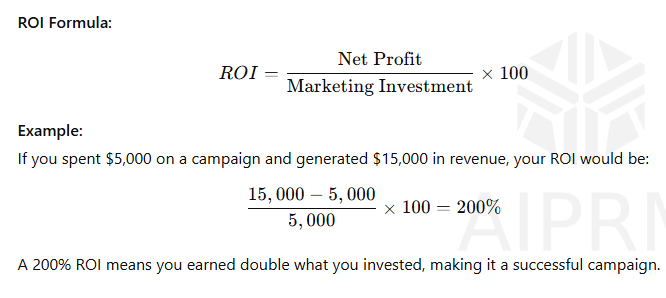The question is how much you are receiving in exchange for the money you are spending on marketing, or in other words, the ROI. When data is applied, it improves on the outcomes of the strategies employed by business organizations, facilitates decision making, and thus increases on the revenues. In this article, we will see how to measure the marketing ROI and the key factors that you should track.
Table of Contents
What is Marketing ROI?
Marketing ROI is the gross value of marketing achieved and then divided by the total marketing expense and is usually presented in percentage form. It just shows the gross profit made to the cost of sales and marketing for the purpose of helping business organizations determine the effectiveness of their advertising strategies.
Why It is Important to Measure Marketing ROI
The problem with using ROI is that there is always the risk to invest in things that do not bring any profit. Measuring ROI enables you to:
ROI Formula:

Why it is Important to Measure Marketing ROI
There is always the danger to spend on non-profitable activities if ROI is not measured. Measuring ROI enables you to:
Identify Top-Performing Channels: Find out which of the channels return the most value.
Allocate Budgets Effectively: Allocate resources directly to the channels that impact the most.
Optimize Campaigns for Better Performance: All the time look for ways on how the actions can be done better to gain higher efficiency.
Demonstrate Value: Prepare marketing budget report to the stakeholders or the management.
Measuring Marketing Return on Investment: Marketing Metrics
Define Clear Goals and KPIs
First of all, but set quantifiable goals. What do you want to accomplish with your product – do you want to increase sales, drive traffic to your website, or capture leads? Define key performance indicators (KPIs) aligned with your objectives, such as:
Sales Growth
Cost Per Acquisition (CPA)
Customer Lifetime Value (CLV)
Lead Conversion Rate
Track Your Marketing Expenses
Aggregate all expenses that are incurred per campaign, including ads costs, tools, content creation and personnel expenses. It helps in making a real estimation of the marketing investments by keeping track of all the expenditures.

Determine the amount of revenue made from every campaign
It is possible to know how much revenue each campaign generates by using tracking tools Every e-commerce business can track the exact sales while others may require to estimate the revenue from the leads or conversions from the marketing channels.
Use Attribution Models
Attribution modeling assists in identifying the various marketing channels that are most responsible for conversion. Models such as:
First-Click Attribution: Acknowledges the first touch point.
Last-Click Attribution: Accredits the last interaction before the purchase decision is made.
Multi-Touch Attribution: For instance, it spreads out credit across several points of contact.
By so doing, you get a better understanding of each channel and its contribution to the business.
Calculate ROI Using the Formula
After you have your revenue and your expenses, plug these into the ROI formula to determine the profitability of each campaign.

Google Ads Mastery 2024 by Rahil Ahmed / Strategies for the Advanced Marketer
Marketing Metrics to Consider for Measuring Marketing ROI
Customer Acquisition Cost (CAC): Total amount of spend by a firm, company or brand, and the number of new customers it has gained. CAC is the cost incurred to acquire a new customer and therefore lower CAC is a good sign.
Customer Lifetime Value (CLV): The expected amount of revenue that a customer will make in the future. Higher CLV means long-term customer value, which can be considered as a source of long-term profit.
Conversion Rate: This is the proportion of the leads or visitors who make a conversion. In most cases, a high conversion rate is an indicator of good targeting.
Sales Growth: You should be able to evaluate the difference in revenue after the campaign in order to determine its success.
Website Traffic & Engagement: High traffics or engagement especially for organic and content driven campaigns mean good impression and audiences’ interest.
Marketing metrics used for Marketing ROI assessment
Google Analytics: Monitors website traffic, conversion rates and source.
CRM Software: It is useful for keeping track of leads, conversions, as well as customers.
Social Media Analytics: Opportunities that encompass general information about engagement and clicks from campaigns on various platforms.
Email Marketing Software: Records the number of times an email is opened, the percentage of people who clicked through the link in the email, and the percentage of people who actually made a purchase after clicking through the link in the email.
Improving Marketing ROI
A/B Test Campaigns: Split test ads, landing pages, and emails to understand which content gets the most engagement.
Refine Targeting: Make sure your ads get to the right people to increase the chances of making a conversion.
Focus on Retention: Customer loyalty also translates to repeat sales hence improving on CLV and ROI.
Automate for Efficiency: Marketing automation tools are cost effective in the sense that they reduce the amount of work that needs to be done manually and yet they are accurate.

Conclusion
Marketing return on investment is very important in order to achieve success in marketing campaigns. If you are systematic and use the right tools, you can figure out what is effective and how to make the best of your efforts and your money.

2 thoughts on “How can a business measure the ROI of their marketing campaigns?”